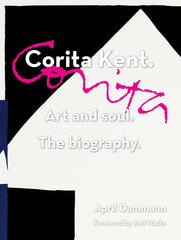Corita Kent. Art and Soul. The Biography.
Corita Kent. Art and Soul. The Biography.
by April Dammann
foreword by Joel Wachs
CORITA KENT. ART AND SOUL. THE BIOGRAPHY. is the painstakingly researched account of one of America’s icons, the nun who made a world of difference and, to her surprise, simultaneously made a name for herself. For the very first time, CORITA KENT. ART AND SOUL. THE BIOGRAPHY. brings readers the life story, the telling artwork, and the unmistakable spirituality of the woman who rose to fame as Sister Mary Corita in the tumultuous 1960s.
On the cover of Newsweek in 1967, Sister Mary Corita became known as the rebel nun. The prototype for every outspoken nun since. Yet Corita was never outspoken. A rebel, yes, but never outspoken. It was her artwork that spoke volumes. Her message was clear. Love. Peace. Joy. Godliness. What would Jesus do, she asked, long before the words became a politicized cliche. Would He go to war? Would He let people starve? Would He judge? Would He not forgive?
Eighteen-year-old Frances Kent joined the Immaculate Heart of Mary order of Catholic nuns in Hollywood in 1936. From the day she became Sister Mary Corita, IHM, her vision expanded, first as nun, teacher, artist, and finally as activist for social justice, distinguishing her from the norm of twentieth century women, and certainly of other women religious.
In post-World War II Los Angeles, Corita found an evolving, unfinished urban environment very much to her liking, full of raw material for her increasingly colorful and textual prints. Her cityscape offered her almost limitless opportunities to take signs as signs—from the road, billboards, supermarket ads and bumper stickers. Corita became a singularly important California artist. As early as 1952, she and her art were recognized by the Los Angeles County Museum of Art as best in show for printmaking. Her work evolved to represent a subversive homage to mass media, giving new meaning to the slogans and marketing manipulations of consumer culture. With a unique calligraphic style and a playful spirit, Corita’s constructions or deconstructions of word and image shook up an art establishment that didn’t quite know what to do with a nun’s bold interpretation of her society.
Corita always had a special outreach to the young. While she was not a “child of the Sixties,” her work was a “voice” of the decade, a voice of peace around the globe, and at the time, comparisons to the impact of Bob Dylan’s and the Beatles’ music were apt. In her smaller world at Immaculate Heart College, Corita strove to teach her students about observing the deepest message in the everyday, the urgency of addressing society’s ills, and the relevance of art as a bridge for human connectedness.
After Vatican II, Corita and her Immaculate Heart sisters enthusiastically embraced their church’s calls for reform, striving to better their teaching conditions in Los Angeles, and to reinvent their spiritual lives. But ecclesiastical authorities relentlessly thwarted their efforts, calling them “bad women” and forcing them into untenable decisions for their futures. For several years, Corita and her artworks became the focus of derision by the Los Angeles archbishop, Cardinal James Francis McIntyre, who found her prints offensive, even despicable.
In 1968, a despondent and trampled Corita took a radical turn toward independence. Fearful but faithful,“Little Heart” left her religious order. She was thereafter known as Corita Kent. Suddenly thrust into a secular world, loose from a tightly controlled environment and separated from her IHM sisters who were her treasured family, she shaped a renewed career, continuing to turn out silkscreen prints that combined image and salient quotations to stunning aesthetic and spiritual effect.
For the next two decades, Corita approached politics from a totally humanistic standpoint and was repeatedly recognized for her profound messages. In 1985, the U.S. Postal Service commissioned her to design the Love Stamp, which sold more than 700 million copies, perhaps the most popular postage stamp ever issued.
Before her death in 1986, Corita Kent bequeathed her complete collection of prints to what is now UCLA’s Hammer Museum. Her internationally revered work will be showcased in Los Angeles in June 2015, when "Someday is Now: The Art of Corita Kent"—a full-scale survey of work by the innovative artist, activist and teacher—opens at the Pasadena Museum of California Art.
- 160 pages
- full color throughout
- 200+ photos and illustrations
- 9" w x 12" h
- hardcover; ISBN 978-1-62640-020-7; $40.00
[CORITA KENT. ART AND SOUL. THE BIOGRAPHY. is independently authored and published, and is not sponsored or endorsed by, or affiliated with, the heirs of Corita Kent, the Immaculate Heart Community, or any other person or organization.]

